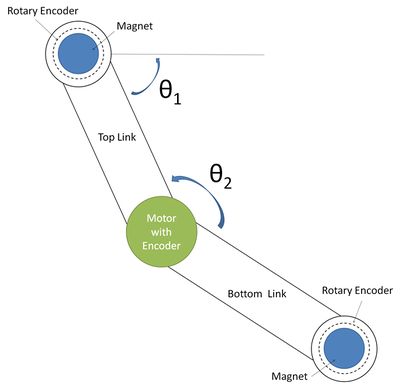Difference between revisions of "Monkeybot"
NathanHenry (talk | contribs) |
NathanHenry (talk | contribs) |
||
| Line 20: | Line 20: | ||
[http://www.youtube.com/watch?v=TA2VcH_GDJ0 Video of the monkeybot climbing] |
[http://www.youtube.com/watch?v=TA2VcH_GDJ0 Video of the monkeybot climbing] |
||
==Geometry== |
|||
[[Image:Monkeybot Geometry|thumb|right|400px|Monkeybot Geometry]] |
|||
==Control Method== |
==Control Method== |
||
Revision as of 21:54, 17 March 2009
Team Members
Nathan Henry - Senior, Mechanical Engineering
Nelson Rosa - Ph.D Student, Mechanical Engineering
Overview
The goal of this project was to create a brachiating robot capable of swinging itself side to side or climbing. This two link robot has electro-magnets on each end and a DC motor at the pivot. With one magnet on, the robot swings under gravity and is aided by a input torque from the motor. This torque allows the swinging robot to overcome friction and pump energy into the system. Once the swinging arm has enough energy, the second magnet reaches a point at the same height or above the first magnet. At this point, the second magnet is turned on the motor is turned off. Now the process is repeated, swinging on the second magnet.
We attempted to control the motor using both a closed loop control, with rotary encoders, and an open loop control, using a time based algorithm.
Video of the monkeybot climbing
Geometry
Control Method
Closed Loop Control
We first attempted to control the DC motor using feedback from a rotary encoder placed directly over each magnet. From this encoder, using both the A and B channels, we are able to determine the sign of the top link's velocity. We then implemented a simple control law in which the motor is full on in the same direction that the top link is rotating. This causes the lower link to pump in phase with the top link, mimicking the motion of a person on a swing set.
With this control law we were able to pump energy into the system, however, we were never able to add enough energy to get the bottom magnet to a height equal to or above the top magnet. Starting from a resting position, with the lower link dangling straight down, the bottom link pumps in phase with the top link. The bottom magnet gradually gets higher and higher, but seems to stop increasing when it reaches a height slightly below the fixed magnet. Friction seems to be the main reason why the robot can not climb.
We also implemented a control law where the lower link pumped out of phase with the top link. This caused a large increase in the movement of the top link, however, the bottom magnet stays in nearly the same position throughout.


